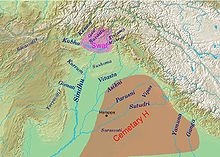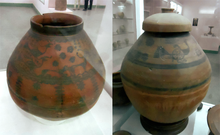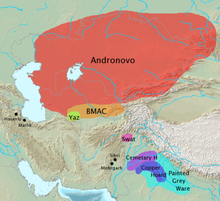
Back Begraafplaas H-kultuur Afrikaans حضارة المقبرة إتش Arabic সেমেটারি এইচ সংস্কৃতি Bengali/Bangla Cultura del Cementeri H Catalan Pohřební kultura H Czech Cemetery-H-Kultur German Cultura del Cementerio H Spanish Kalmisto H -kulttuuri Finnish Cultura del cimitero H Italian ഹരപ്പൻ ശ്മശാനസംസ്കാരം Malayalam
 The extent of the Swat and Cemetery H cultures are indicated; Geography of the Rigveda, with Rigvedic rivers names | |
| Geographical range | Pakistan North India (Punjab, Haryana, Western Uttar Pradesh) |
|---|---|
| Period | Bronze Age |
| Dates | c. 1900–1300 BCE |
| Type site | Harappa |
| Major sites | Harappa Bhagwanpura |
| Characteristics | Extensive copper metallurgy cremation of human remains |
| Followed by | Painted Grey Ware culture |


| History of India |
|---|
 |
| Timeline |
| History of South Asia |
|---|
 |
The Cemetery H culture was a Bronze Age culture in the Punjab region in the northern part of the Indian subcontinent, from about 1900 BCE until about 1300 BCE. It is regarded as a regional form of the late phase of the Harappan (Indus Valley) civilisation (alongside the Jhukar culture of Sindh and Rangpur culture of Gujarat), but also as the manifestation of a first wave of Indo-Aryan migrations[citation needed], predating the migrations of the proto-Rig Vedic people.